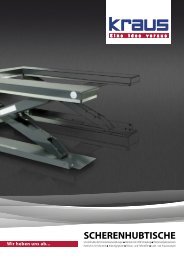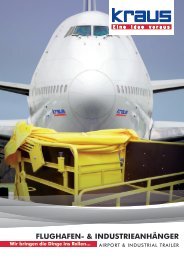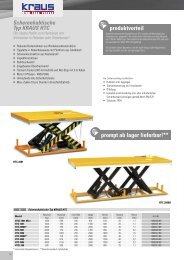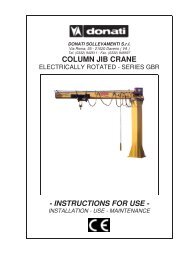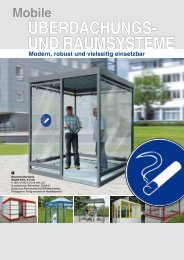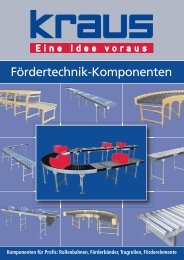JIB CRANES WITH AN ARTICULATED ARM MANUALLY ROTATED
JIB CRANES WITH AN ARTICULATED ARM MANUALLY ROTATED
JIB CRANES WITH AN ARTICULATED ARM MANUALLY ROTATED
You also want an ePaper? Increase the reach of your titles
YUMPU automatically turns print PDFs into web optimized ePapers that Google loves.
DONATI SOLLEVAMENTI S.r.l. - Via Roma, 55 - 21020 Daverio (VA) - Tel. 0332 942611 - Fax. 0332 948597<br />
• ALWAYS when moving manually push the load and avoid pulling it towards itself<br />
• ALWAYS ensure the lifting unit (hoist and hook) is centered on the perpendicular of the load<br />
before slinging and moving it.<br />
• ALWAYS appropriately secure the load slings to the lifting hook and stretch the slings with<br />
slow, safe movements.<br />
• ALWAYS operate in the best conditions as far as lighting and load visibility are concerned.<br />
• ALWAYS ensure, before maneuvering, that the rotation of the arm is free from obstacles and<br />
that during lifting, travelling and rotation, the load does not meet obstacles<br />
• ALWAYS operate outside the maneuvering area of the lifted load.<br />
• ALWAYS carry out the handling avoiding jogging.<br />
• ALWAYS avoid to cause hunting of the load.<br />
• ALWAYS use “slow” speeds for approaching and positioning operations.<br />
• ALWAYS at the end of work, position the crane arm, the load hook and the push-button panel,<br />
so they are not a collision risk .<br />
• ALWAYS push the red emergency stop button on the push-button panel before leaving the<br />
command post and switch off the cutout switch of the crane.<br />
• ALWAYS switch off power to the machine during checks, repairs, ordinary maintenance.<br />
• ALWAYS for all operations, use adequate safety protection devices (DPI, gloves, etc.)<br />
• ALWAYS point out any functioning anomalies (faulty working, possible breakings, incorrect<br />
movements and unusual noise) to the person in charge of the specific department and put the<br />
machine out of service.<br />
• ALWAYS follow the maintenance programme and record, for each check, any specific<br />
observations, especially regarding the hook, chains, brakes, and limit switches.<br />
5.6 - Contraindications of use<br />
• The use of the jib crane for manoeuvres which are not permitted, improper<br />
use and a lack of maintenance can carry risks of grave danger for the<br />
health and safety of the operator and of the people in the area, as well as<br />
risks of damage for the work environment and can compromise the<br />
functionality and intrinsic safety of the machine.<br />
• The actions described below, which obviously cannot cover the entire<br />
range of possible “bad uses” of the crane, are the most predictable ones,<br />
and are absolutely forbidden::<br />
5.6.1 Use not intended and not allowed - Foreseeable and unforeseeable inappropriate use<br />
• NEVER use the crane to lift and transport people.<br />
• NEVER lift loads heavier than the nominal lifting capacity nor equip the crane with hoists with a nominal<br />
lifting capacity greater than that of the crane itself.<br />
• NEVER lift loads while people are walking under the suspended load.<br />
• NEVER walk, stop, operate and maneuver under the suspended load.<br />
• NEVER permit unqualified staff or under 16 years of age to use the crane.<br />
• NEVER use the crane unless psychophsically suited to the work.<br />
• NEVER use the crane unless provided with suitable personal protection (PPD, gloves,etc.)<br />
• NEVER operate without taking the necessary care during lifting and travelling and rotation of the arm<br />
maneuvers.<br />
• NEVER rotate the arms of the crane using the cable of the push button panel<br />
• NEVER touch the slings during tensioning in contact with the load and between the hook and the<br />
slinging.<br />
• NEVER leave the suspended load unattended.<br />
• NEVER use the crane for jobs other than those for which it was designed, do not use it for other<br />
operations such as painting ceilings, changing light bulbs, a place to rest scaffolding on, etc.<br />
• NEVER lift unbalanced loads<br />
• NEVER allow the load or the hook to swing during translation or rotation.<br />
• NEVER place the chain in a diagonal position for pulling.<br />
• NEVER use the crane or its lifting apparatus for pulling or dragging.<br />
• NEVER use slingings without having previously checked their suitability.<br />
• NEVER use the chain of the hoist for grounding a welder.<br />
• NEVER lift loads with the hoist<br />
43



